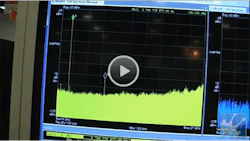Signal Analyzer Merges FFT With Swept-Spectrum Capabilities
Watch the Engineering TV video to see the "step spectrum analysis" approach.
Agilent Technologies recently showcased its fast-Fourier-transform (FFT)-based PXI signal analyzer, which has the ability to “sweep” a FFT window over multiple gigahertz frequencies much like swept spectrum analyzers. The FFT offers a simpler, more efficient way to analyze signals. Better Explained comments, “The Fourier Transform takes a time-based pattern, measures each [cycle strength, offset, & rotation speed], and returns the overall [frequency graph].”
This new “step spectrum analysis” approach uses a display with vector signal analyzer software. It takes 160-MHz FFT bins and stitches them together, then sweeps the display across a wide range of gigahertz frequencies. The signal is still the same at 5.8 GHz with -36 dBm as it was when taking an FFT over the sample range. The added factor is now the second harmonic signal being produced by this amplifier is visible in a single sweep without having to adjust the FFT window.
Until now, the benefit of swept spectrum analysis was the ability to view harmonic measurements, unlike with FFT (which only offerd in-band measurements). In the video, Joan Gibson of Agilent discusses the differences between stepped and swept spectrum analysis, while demonstrating what FFT can contribute.
Check out other videos from IMS 2014 over at Engineering TV.
